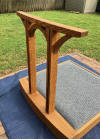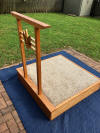Steve Wavro started off by stressing the importance of taking the time to study your pattern BEFORE cutting to specifically look for small pieces. In many cases, the pattern can be modified to eliminate the need for the small pieces, and if it cannot, then the next best thing is to think about the ways it can be cut safely. Steve used two finished Intarsia projects and their patterns to show examples of how he analyzed the patterns before cutting and showed specific examples of where small leaves and flower petals could be combined without affecting the overall project. He also discussed cutting eyes for intarsia projects and said that he typically will use ebony for eyes that are at least 1/2" diameter and prefers to use dowels for eyes that are less than 1/2". He demonstrated his technique for rounding the end of a dowel, and said that rounded edge could then be safely blackened with a wood burner and then cut to length on a scroll saw.
Steve also bought in a 130-piece jigsaw puzzle he made for his grandson.
Steve mentioned that for children over 3, he typically uses a #2 or #3
blade, depending on whether he is cutting a single puzzle or stack
cutting. For toddlers aged 1-3, he prefers to use a #5 blade Puzzle
because the larger kerf makes it easier for them to assemble.
Puzzle patterns and instructions are available in an e-book from Steve
Good for $7 at: https://www.stevedgood.com/estore/estore.html
Denis Muras’ presentation was not about
working on small parts but working a big part to be later cut down to
small parts. Denis proceeded to explain that he plans his work to make
long pieces with a specific profile, properly sands them to perfection
before using a table saw to precisely cut them to length, having the
pieces falling away from the blade.
Dave Vadewerker explained his techniques for working with small parts.
Download Dave's write-up, "Sanding Small Pieces."






